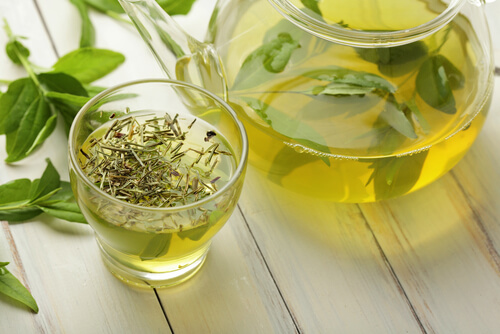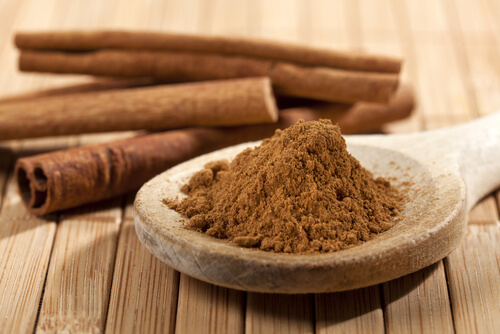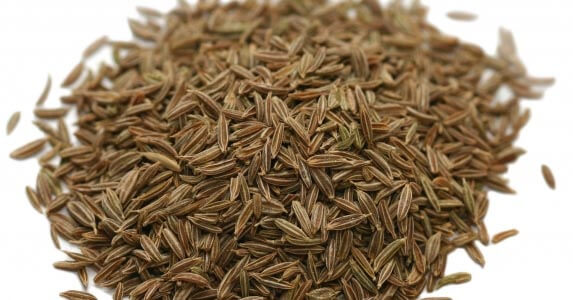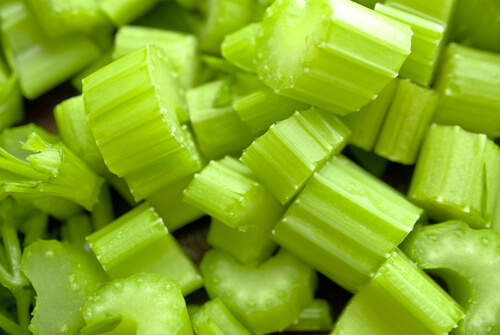9 Medicinal Plants for Weight Loss


Reviewed and approved by Doctor Carlos Fabián Avila
As an alternative to expensive, commercial products, you should know that are also great medicinal plants for weight loss. They’re effective and economical.Always remember: you have to combine them with a proper diet and good exercise. With that in mind, we’ve made a list of 9 of these medicinal plants for weight loss.
Green tea

This is definitely one of the most popular medicinal plants for weight loss. Its works because it contains antioxidants that help burn fat in less time. You can have it a few times a day and even drink it as an alternative to other beverages.
It’s important to drink green tea every day and combine it with a balanced diet and at least 30 minutes of daily exercise.
Read more:
Linseed and Green Tea, Allies Against Cancer
Aloe vera: one of the most popular medicinal plants for weight loss
Aloe vera has detoxifying properties that improve digestion and help burn fat. It’s one of the most used plants because for this because it can give significant results in weeks and is a cost-effective alternative. One of the best ways to have it is blended into a honey-sweetened citrus juice.
Cinnamon

Mustard
Mustard is a cruciferous plant, like broccoli, cauliflower, and cabbage. Research has shown that its seeds can increase your metabolism by up to 25%. This means that it can help you burn calories faster. We recommend having a 3/5 teaspoon of seeds a day, which will make you burn 45 extra calories an hour.
It’s very important to not to go beyond that much mustard. Doing that have serious consequences for your health.
Cumin

Cumin has very beneficial properties for digestion and energy production. It’s also helpful in controlling the glycemic index for people with type 2 diabetes. It’s a good dietary supplement to help deal with anxiety, eliminate toxins from the body, and lose weight.
Artichoke
Artichokes have depurative, diuretic, and laxative properties. It’s another one of the most popular medicinal plants for weight loss. In fact, many commercial weight loss products use it as their main ingredient. We recommend using fresh artichoke leaves in a tea.
You might like:
6 Benefits of Artichokes For Your Health
Birch
Birch has diuretic properties and is a great way to fight obesity. Its properties help eliminate toxins from the body and prevent fat build-up. We recommend making a tea with 1 or 2 teaspoons of birch in 1 cup of water.
Celery

Cut a raw celery stalk and boil it for 30 minutes. Then, strain the water and drink it at least three times a day.
Cayenne pepper
Cayenne pepper has an ingredient called capsaicin, which is what gives it its hot, spicy flavor. That substance also has weight loss benefits. It brings down calorie intake, which reduces fatty tissue and the levels of fat in the blood.
Its properties activate certain proteins in the body that can help prevent fat build-up.
All cited sources were thoroughly reviewed by our team to ensure their quality, reliability, currency, and validity. The bibliography of this article was considered reliable and of academic or scientific accuracy.
- The effects of green tea on weight loss and weight maintenance: a meta-analysis (2009). Hursel R, Viechtbauer W, Westerterp-Plantenga MS.
https://www.ncbi.nlm.nih.gov/pubmed/19597519 - Mollazadeh, H., & Hosseinzadeh, H. (2016). Cinnamon effects on metabolic syndrome: a review based on its mechanisms. Iranian journal of basic medical sciences, 19(12), 1258-1270.
https://www.ncbi.nlm.nih.gov/pmc/articles/PMC5220230/ - McCarty, M. F., DiNicolantonio, J. J., & O’Keefe, J. H. (2015). Capsaicin may have important potential for promoting vascular and metabolic health. Open heart, 2(1), e000262. doi:10.1136/openhrt-2015-000262
https://www.ncbi.nlm.nih.gov/pmc/articles/PMC4477151/ - The effects of hedonically acceptable red pepper doses on thermogenesis and appetite (2011). Ludy MJ, Mattes RD.
https://www.ncbi.nlm.nih.gov/pubmed/21093467 - Wider, B., Pittler, M. H., Thompson-Coon, J., & Ernst, E. (2013). Artichoke leaf extract for treating hypercholesterolaemia. Cochrane Database of Systematic Reviews, 3
onlinelibrary.wiley.com/doi/10.1002/14651858.CD003335.pub3/pdf - Taghizadeh, M., Memarzadeh, M. R., Abedi, F., Sharifi, N., Karamali, F., Fakhrieh Kashan, Z., & Asemi, Z. (2016). The Effect of Cumin cyminum L. Plus Lime Administration on Weight Loss and Metabolic Status in Overweight Subjects: A Randomized Double-Blind Placebo-Controlled Clinical Trial. Iranian Red Crescent medical journal, 18(8), e34212. doi:10.5812/ircmj.34212
https://www.ncbi.nlm.nih.gov/pubmed/21093467 - Jurgens TM, Whelan AM, Killian L, Doucette S, Kirk S & Foy E. Té verde para bajar de peso y mantener el peso en adultos con sobrepeso u obesidad. Base de Datos Cochrane de Revisiones Sistemáticas 2012, Número 12. Art. No .: CD008650. DOI: 10.1002 / 14651858.CD008650.pub2. https://doi.org/10.1002/14651858.CD008650.pub2
- Ruiz Caubín, A. F.; Ruiz Caballero, J. A.; Brito Ojeda, E. Mª. & Navarro García, R. (2012). Aplicaciones terapéuticas del Aloe Vera. Departamentos de Educación Física y Ciencias Médicas y Quirúrgicas, Hospital Universitario Insular de Gran Canaria.
Universidad de Las Palmas de Gran Canaria https://sudocument.ulpgc.es/bitstream/10553/7903/1/0514198_00027_0009.pdf - Timothy Romero & Peter Miller (2015). Dietary Supplements Containing Extracts of Cinnamon and Methods of Using Same to Promote Weight Loss. US20060013903A1 Estados Unidos. https://patents.google.com/patent/US20060013903A1/en
- Efecto de la Ingesta de Cápsulas de Canela (Cinnamomum Zeylanicum) 500mg, sobre el nivel de Glucosa en Pacientes con Diabetes Mellitus Tipoii e índice de masa Corporal (2019). Loayza López, Marpia Antonieta; Quispe Carbajal & Hely Norka. Universidad Andina Néstor Cáceres Velásquez. Facultad de Ciencias de la Salud. http://repositorio.uancv.edu.pe/handle/UANCV/4114.
- Aboulfadl, Mostafa & El-Badry, N. & Ammar, Mohamed. (2011). Nutritional and Chemical Evaluation for Two Different Varieties of Mustard Seeds. World Applied Sciences Journal. 15. 1225-1233. https://www.researchgate.net/profile/Mohamed_Ammar17/publication/279597329_Nutritional_and_Chemical_Evaluation_for_Two_Different_Varieties_of_Mustard_Seeds/links/598e1a8a0f7e9bf4fbb017f7/Nutritional-and-Chemical-Evaluation-for-Two-Different-Varieties-of-Mustard-Seeds.pdf
- Beatriz Mejía-Garibay, José Ángel Guerrero-Beltrán, Enrique Palou & Aurelio López-Malofile. Características físicas y antioxidantes de semillas y productos de mostaza negra (Brassica nigra) y amarilla (Brassica alba). Archivos latinoamericanos de Nutrición, Órgano Oficial de la Sociedad Latinoamericana de Nutrición, Vol. 65 N° 2, 2015. México. :///C:/Users/pc/Downloads/100-Article%20Text-99-1-10-20180905.pdf
- B. Mejía- Garibay, A. López- Malo, J. A & Gerrero- Beltrán (2011). Mostaza: características químicas, botánicas y sus aplicaciones en el área de alimentos. Departamento de Ingeniería Química, Alimentos y Ambiental, Fundación Universidad de las Américas Puebla, México. https://www.udlap.mx/WP/tsia/files/No5-Vol-1/TSIA-5(1)-Mejia-Garibay-et-al-2011.pdf
- Ana Mª Camean (2006) y Manuel Repetto (2012). Toxicología Alimentaria. https://books.google.es/books?hl=es&lr=&id=SbUticcNWoMC&oi=fnd&pg=PA237&dq=consumo+de+semillas+de+mostaza+calorias+bajadas&ots=rlAonR8FoN&sig=VYwLj5jckjQSx1fiybVeBgi016M#v=onepage&q=mostaza&f=false
- Aguilar G., S., Briceño A., L., Negrón B., L., & Arnao S., I. (2014). Estudio bioquímico y nutricional del extracto liofilizado del fondo de alcachofa Cynara scopolymus . Ciencia E Investigación, 3(2), 34-41. Recuperado a partir de https://revistasinvestigacion.unmsm.edu.pe/index.php/farma/article/view/5320http://jdn.zbmu.ac.ir/browse.php?a_id=270&slc_lang=en&sid=1&printcase=1&hbnr=1&hmb=1
- Martínez-Álvarez, Jesús Román, Gómez-Candela & C, Villarino-Marín, A. L (2006). Revista de Medicina de la Universidad de Navarra. https://revistas.unav.edu/index.php/revista-de-medicina/article/view/7616
- Drs.: Nelson Ramirez Rodriguez, Cecilia Pabón Uego, Eduardo Ortiz, Luis Duchen & Adrián Ávila. Herbal poisoning with possible association with Reye syndrome. Rev. bol. ped. v.43 n.2 La Paz jun. 2004. http://www.scielo.org.bo/scielo.php?pid=S1024-06752004000200007&script=sci_arttext
- Gorji, Negar E.; Farzanegi, Parvin; Habibian, Masoumeh; Mahdirejei, Hassan A. & Abadei, Sajedeh F. R. Celery as an Effective Supplement for Pilates Exercise in Weight Loss Studies.International Medical Journal . Jun2015, Vol. 22 Issue 3, p190-193. 4p. https://web.a.ebscohost.com/abstract?direct=true&profile=ehost&scope=site&authtype=crawler&jrnl=13412051&AN=103400502&h=d%2bZKIfWLtGw9Li5SlcG7eEJ1viIB6Ni%2fABoj%2f8qIVpRiha8fNg3k7q757G4KrWzr%2f2OSXnoQ9riQzjojOUd%2blA%3d%3d&crl=c&resultNs=AdminWebAuth&resultLocal=ErrCrlNotAuth&crlhashurl=login.aspx%3fdirect%3dtrue%26profile%3dehost%26scope%3dsite%26authtype%3dcrawler%26jrnl%3d13412051%26AN%3d103400502
- Maljaei, M. B., Moosavian, S. P., Mirmosayyeb, O., Rouhani, M. H., Namjoo, I., & Bahreini, A. (2019). Effect of Celery Extract on Thyroid Function; Is Herbal Therapy Safe in Obesity?. International journal of preventive medicine, 10, 55. https://doi.org/10.4103/ijpvm.IJPVM_209_17
- Sogut, O., Kaya, H., Gokdemir, M.T. et al. Acute myocardial infarction and coronary vasospasm associated with the ingestion of cayenne pepper pills in a 25-year-old male. Int J Emerg Med 5, 5 (2012). https://doi.org/10.1186/1865-1380-5-5.
This text is provided for informational purposes only and does not replace consultation with a professional. If in doubt, consult your specialist.








